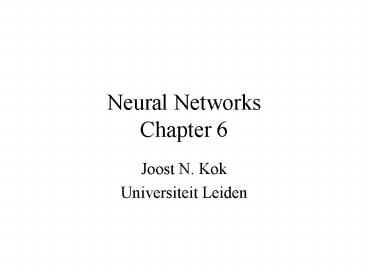Neural Networks Chapter 6 - PowerPoint PPT Presentation
Title:
Neural Networks Chapter 6
Description:
1 hidden layer with 80 hidden units. 26 output units encoding phonemes ... One for wrongly on patterns. One for wrongly off patterns ... – PowerPoint PPT presentation
Number of Views:34
Avg rating:3.0/5.0
Title: Neural Networks Chapter 6
1
Neural NetworksChapter 6
- Joost N. Kok
- Universiteit Leiden
2
Feedforward networks
3
Feedforward networks
4
Feedforward Networks
5
Feedforward Networks
6
NetTalk
7
NetTalk
8
Feedforward Networks
- A network to pronounce English text
- 7 x 29 input units
- 1 hidden layer with 80 hidden units
- 26 output units encoding phonemes
- Trained by 1024 words with context
- Produces intelligible speech after 10 training
epochs
9
Feedforward Networks
- Functionally equivalent to DEC-talk
- Rule-based DEC-talk is the result of a decade of
efforts by many linguists - NETtalk learns from examples, and requires no
linguistic knowledge
10
Back-Propagation
11
Back-Propagation
12
Back-Propagation
13
Back-Propagation
14
Back-Propagation
- Initialize the weights to small random values
- Choose a pattern and apply it to the input layer
- Propagate the signal forwards through the network
- Compute the deltas for the output layer
15
Back-Propagation
- Compute the deltas for the preceding layers by
propagating the errors backwards - Update all the connections
- Go back to the second step for the next pattern
16
Feedforward Networks
17
Feedforward Networks
18
Navigation of a Car
- Carnegie-Mellon
- 30 times 32 pixel image
- 8 times 32 range finder
- 29 hidden units, 45 output units
- 1200 simulated road images, 40 training cycles
- 5km/hr
19
Feedforward Networks
20
Backgammon
- Score from 100 to 100
- 3000 examples
- 459 inputs
- Two hidden layers of 24 nodes
- Neurogammon vs. Gammontool 59 percent
- Without precomputed features 41 percent
- Without noise 45 percent
21
Feedforward Networks
22
Feedforward Networks
23
(No Transcript)
24
Parity Problem
- Parity Problem Output is on if an odd number of
inputs is on
25
Back-Propagation
26
Back-Propagation
27
Back-Propagation
28
Back-Propagation
29
Back-Propagation
- The update rule is local
- Incremental weight updating vs. batch mode
- Momentum accelerate the long term trend by a
factor
30
Back-Propagation
- Adaptive parameters
31
Feedforward Networks
- Process Modeling and Control
- Machine Diagnostics
- Portfolio Management
- Target Recognition
- Medical Diagnosis
- Credit Rating
32
Feedforward Networks
- Targeted Marketing
- Voice Recognition
- Financial Forecasting
- Quality Control
- Intelligent Searching
- Fraud Detection
33
Optimal Network Architectures
- Optimization
- Use as few units as possible
- Improve computational costs and training time
- Improve generalization
- Search through space of possible architectures,
for example using Back-Propagation and
Evolutionary Algorithms
34
Optimal Network Architectures
- Construct or modify architecture
- Start with too many nodes and take some away
- Start with too few and add some more
35
Optimal Network Architectures
- Pruning and weight decay
36
Optimal Network Architectures
- Small weights decay more rapidly than large ones
37
Optimal Network Architectures
- We want to remove units use same for all
connections feeding unit i
38
Optimal Network Architectures
- Start with small network and gradually grow one
of the appropriate size - Boolean function from N binary inputs to single
binary output
39
Optimal Network Architectures
40
Optimal Network Architectures
- Choose hidden units such that
- Same output for all remaining patterns with one
target - Opposite output for at least one of the remaining
patterns with opposite target and remove these
patterns - Linearly separable problem
41
Optimal Network Architectures
42
Optimal Network Architectures
- We do the best we can with single node
- Correct with two nodes
- One for wrongly on patterns
- One for wrongly off patterns
- Each additional unit reduces the number of
incorrectly classified patterns by at least one
43
Optimal Network Architectures
44
Optimal Network Architectures
- Faithful representation two patterns with
different targets should have different
representations - Master unit does as well as possible on the task
- Ancillary units added to obtain faithful
representation































